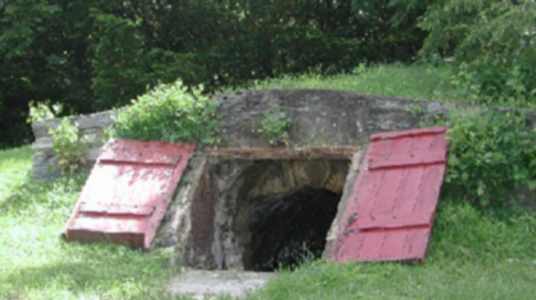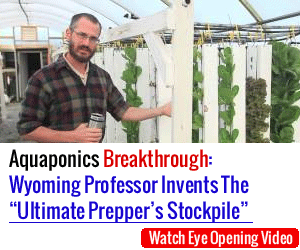How to Build an Underground Root Cellar
Your garden has come in and the bounty of it has been dispersed to family and friends. However, you still have more produce than you can consume. What to do? You can process some of it in a pressure canner or freeze it. Some vegetables, though, and a few fruits do not do well canned or frozen. Perhaps it is time to build an underground root cellar.
Pros and Cons to Using a Root Cellar
The biggest positive aspect of using a root cellar is the simplicity. Once you have the right location and conditions set up, you just store your produce in baskets or buckets and leave as-is in the cellar until you are ready to use them.
The problems come from trying to get the right conditions for what you are going to store and that this method will only extend the life of your food for a few months or possibly to a full year if you are lucky. That’s fine for standard food preservation from one season to the next but it usually isn’t the right type of time frame that you need for a good emergency food storage system.
There are also limits one what kind of food will store this way. Most root vegetables (potatoes, turnips, beets) and apples are well-known for great root cellar storage.
The Conditions
The specifics of where or how you build a root cellar are less important that you are able to achieve the right environment once it’s in use. Not all vegetables will store best under the same conditions but you should have a space that stays between 32 and 38F (0 and 3C) without dipping below freezing. Humidity should also be very high, around 90%. The temperature is much easier to maintain naturally during the winter months, which is why this method works so well as a yearly method to save fresh produce until the next season. Once you are storing through the summer, most underground places will be too warm.
You also need to allow for ventilation. Gases can build up that will hasten the ripening (and degradation) of your food so you have to have some sort of venting to the outside for fresh air. Because air should be moving, you will have to have a source of moisture present to keep the humidity level up. A room that has a dirt floor will usually be damp enough but if you do not have that source for moisture, then you can keep a few buckets of wet sand among your stores. Just add more water to it as the sand dries out. Keeping a hygrometer in the room to measure humidity is a very good idea.
Take note that other types of storage food (canned goods for example) should not be stored along with your produce in a root cellar. The high moisture levels will rust cans very quickly so reserve your root cellar for unpackaged foods only.
Root Cellar Construction
Understand that the key elements of a root cellar have to do with temperature, humidity and ventilation. Keep these three details in mind and the cellar can be built using just about any method.
- Building material options include native stone, concrete cinder blocks, earth-packed tires or cedar logs for walk-in root cellars. The most common of these is to use concrete cinder blocks. This material is readily available from a DIY store.
Think out of the box for your underground root cellar.
- Use a fiberglass water tank. These will be easy to modify and bury.
- Bury a 50-gallon plastic drum in the ground.
Cover either of the above choices with 1 foot (30.48) of dirt or other coverage for temporary fall storage.
Locate your root cellar in an area that has good drainage away from it. Ideally, this would be on a hill side facing north and limiting exposure to the opening of the cellar.
Excavate for the root cellar so that, when the walls are buried, you have at least 4 feet (1.22 meters) of coverage. Ten feet (3.05 meters) is even better.
Vent the cellar by installing two PVC pipes. One pipe must enter the root cellar low to the floor to let cool air in, and the other one needs to be near the ceiling to vent out hot air.
- The vent pipes will need to be screened to keep out pests and to protect the produce from weather that is too cool or too warm. Remember, cool air settles and warm air rises.
- Ventilation is also important to remove ethylene gases that fruit and vegetables produce as they ripen. Venting ethylene gases slows down the ripening process.
Create an entry to the root cellar.
- The door to the root cellar plays a double roll — to keep the varmints and unwanted visitors out and to keep the cool air in.
- Most root cellars have 1 door at the surface and a second at the wall that opens to the root cellar (if this exists). This entry way acts as a little extra insulation in the form of dead space to keep the cool air in.
Cover the floor of your root cellar with gravel or even a concrete floor. Either one can be wet down to help raise the humidity when you need it.
Choose wooden shelves over metal. Metal transmits heat, warming up faster that wood. Wood helps you keep the temperature more in control as a result.
Place a temperature and humidity gauge in the cellar and keep a record of the readings. This will help you to track how effective these numbers are and reflect the best way to maintain your root cellar.
How to Use Your Cellar
Unlike most other types of storage methods, you do not necessarily want your food to be sealed up in a container. The whole point of the root cellar is to expose your food items to the environment. Cardboard boxes, open buckets and baskets will all work relatively well. You just need to protect against pests. You can cover your containers with woven wire mesh screen to keep out any rodents, which will be a problem in many dirt floor cellars unless the floor is already lined with screen.
When storing root vegetables, do not wash them first. Leave them dirty, especially if you have pulled them yourself from the garden. Store-bought vegetables will have little dirt on them to start with so its not that important. This helps keep them moist in storage. Also leave on outer peels, rinds and leaves before storage. As natural as possible works best. A little added insulation inside each box is another good idea. Sawdust, wood shavings or even newspaper will work to pack your food in.
You should always keep an eye on a root cellar and inspect your food regularly. Anything that is starting to go bad should be removed immediately as it will spread quickly and ruin an entire basket or bushel. If anything is starting to shrivel or dry out, take it out for immediate use.
Ethylene Gas
There is one additional concern you have to be aware of with storing a variety of foods in a root cellar, and that is ethylene. It’s a natural gas given off by some fruits and vegetables as they ripen. Apples are particularly notorious for this. Too much of this gas building up in your root cellar will hasten ripening and further decomposition, which is obviously not desirable. With many root vegetables, like potatoes or carrots, it will cause them to toughen up considerably and get bitter so even if they do not rot, they will be inedible.
The easiest solution is to not store apples at all. But since they are one of the best fruits for root cellar storage, most people would rather not do that. Alternatively, you can keep your root cellar divided with separate vents and fresh air sources so that your fruit can be stored away from the other vegetables. This may be a possibility if you are constructing a sizable cellar in the first place or have a basement area that is divided into multiple rooms.
If neither of these suits, you will have to make do by storing your apples high within the cellar and close to the vents to let the gas escape without effecting the other food.
And apples are not the only culprits here, though they are typically the worst offenders. Pears, peaches, and cantaloupes are other fruits to watch out for.
Survive Attack to Our Power Grid System (Weapon That Can Instantly End Modern Life in America)
Survival MD (Best Post Collapse First Aid Survival Guide Ever)
Backyard Innovator (A Self Sustaining Source Of Fresh Meat,Vegetables And Clean Drinking Water)
Blackout USA (EMP survival and preparedness)
Conquering the coming collapse (Financial advice and preparedness )
Liberty Generator (Build and make your own energy source)
Backyard Liberty (Easy and cheap DIY Aquaponic system to grow your organic and living food bank)
Bullet Proof Home (A Prepper’s Guide in Safeguarding a Home )
Family Self Defense (Best Self Defense Strategies For You And Your Family)
Survive Any Crisis (Best Items To Hoard For A Long Term Crisis)
Survive The End Days (Biggest Cover Up Of Our President)
Drought USA(Discover The Amazing Device That Turns Air Into Water)





Love the mole hole and will share it on an upcoming issue of our Poor Man Survival blog!